한식 읽기 좋은 날
Vol 25. Jukkumi - Chungcheong
Gourmet travel for regional food ingredients
Taste of spring that cannot be given up despite
‘Covid-19’
Gourmet travel for food ingredients
Edited by Choi Kyuseung – Photographed by Han Heeseok
Published by Korean Food Promotion Institute Foundation
Hansik glossary
Jukkumi - Webfoot Octopus
Nakji - Octopus
Muneo - Octopus
While spring is here, it doesn’t seem so
This statement in ‘Sogunwon 昭君怨’, the poem of Dongbanggyu as the poet of Tang Dynasty, was on everyone’s lips by frequent citation as the figure of speech alluding to political and social situations as well as life for more than 2 thousand years irrespective of the original meaning of the poem. If another is to be added to the numerous figures of speech, this statement would not fall short of revealing people’s daily life. In the spring of 2020 with the world changed and daily life tied up by ‘Covid-19’, we see the world where ‘distancing from spring’ has become prioritized over anything else, disabling full enjoyment of the spring even if it is here.
This year nature did not fail to see spring after winter was over. While birds, wind, and flowers are clearly amid spring, only people had no choice other than watching the spring from far away. Although the spring of nature has come, people of the world could not meet the spring because of the invisible tiny virus. Now, the might of Covid-19 was great to the extent that one cannot dispute the saying of being unable to return to before any more. People ended up by being besieged slowly beginning with the middle of February on the tail of winter and then abruptly by virus. Being trapped at home and in masks, people could only fathom the season only by a calender while being far removed from spring.
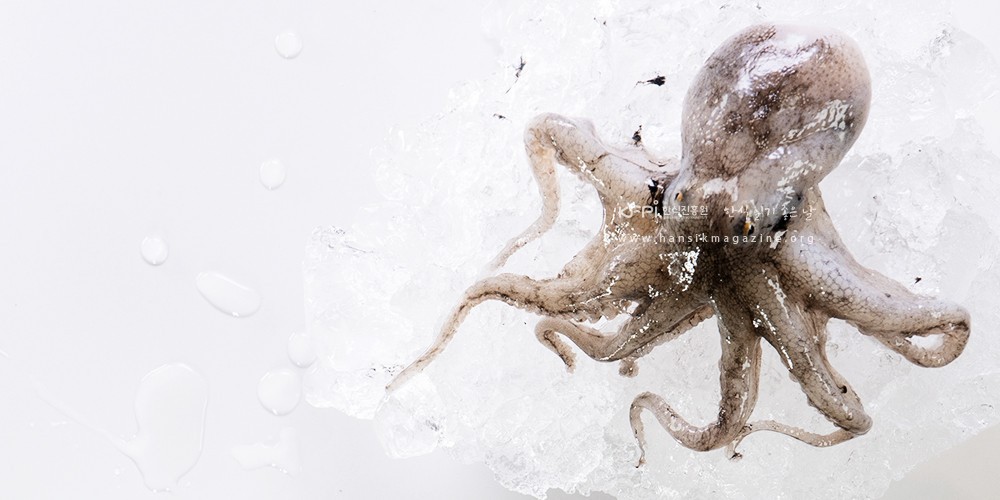
Jukkumi for spring and Nakji for autumn
Nevertheless, vitality overflows just by looking at spring. Isn’t it why some poet said “Spring is a cat”? The signals notifying spring come with spring flowers. After all, spring is represented by flowers. Unlike the flowers of other seasons, ‘Spring flowers’ may be listed in a dictionary as one word for that reason. While ‘summer flower’, ‘autumn flower’, ‘winter flower’ are subject to spacing, the springflower has no spacing. However, wouldn’t the camellia flower having passed winter be most fitting as the herald of spring?
Camellia is a flower that begins to blossom from the end of October in Jeju Island, moving north throughout winter to blossom until March next year, and may be considered as a winter flower rather than a springflower strictly speaking. Certainly, it is divided into autumn camellia, winter camellia, and spring camellia depending on the blossoming time. The reason for the representative name being winter camellia would be that it blossoms across the winter. While numerous springflowers boast themselves decorating spring glamorously, the camellia lets itself known with the singleness of heart, and departs without regret by falling off “like tears“ as included in some lyric.
In March, camellia notifies the complete spring and falls off in a magnificent manner. With an exception of islands, the northernmost side of Korean peninsula where the great spectacle can be witnesses is the camellia tree forest (Natural Monument No.169) at Seocheon Maryang-ri on the west coast of Chungcheong-do. Camellia having come up to here stops going north to leave the spring alone. Around the time when the red-blossomed camellia falls off one by one, another herald of spring appears in the front sea of Seocheon, Maryang port.
As the saying goes ‘Jukkumi(Webfoot octopus) for spring and Nakji(Octopus) for autumn’, the Jukkumi lets the spring known through people’s palate if the camellia of falling flower is the visual herald of spring. Looking at the Jukkumi with the weight put on fresh, it can be seen to strangely resemble the camellia flower. According to the recent in-word, it has a ‘synchro ratio of almost 100%’. Perhaps for such reason, “Seocheon camellia flower Jukkumi festival’ is held in Seocheon-gun of Chungnam at the end of March every year. Although association of camellia flower and Jukkumi is somewhat awkward, there may not be such customized combination, when the season and the region, appearance are considered.
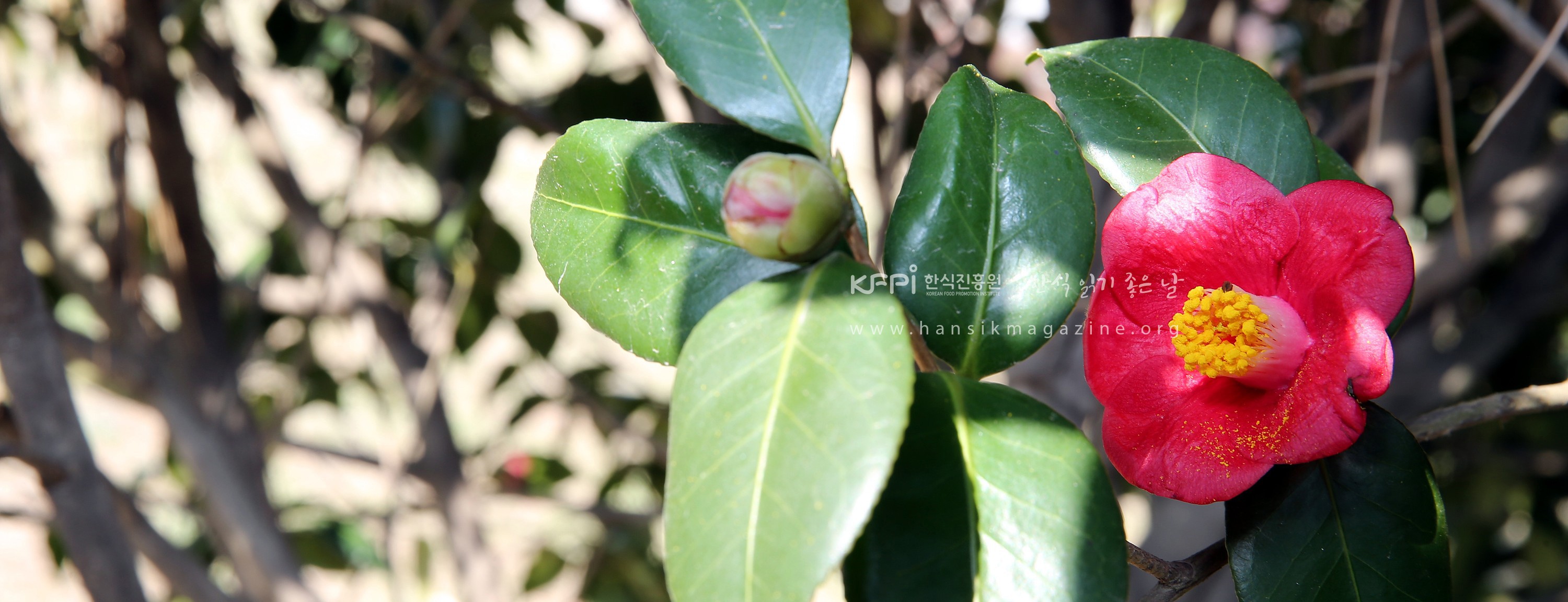
Jukkumi is not a dish
Spring is a good season for travel. For something that allows the momentary release of body and mind after contraction throughout winter, there is no such thing as travel. There won’t be an instant where the expression of swelling of body and mind is so appropriate as at this time. However, the contracted body and mind is further shrunk, let alone being swollen. Because of the social distancing, no one dare to think about travel. After all, the festivals of letting spring known have been cancelled one after another, and the camellia and Jukkumi of Seocheon have become unable to inform the people of spring.
But that does not mean that you can skip spring to go to summer. Not being able to go back to the life before Covid-19 does not necessarily mean being gloomy. Aren’t there non face-to-face festivals tailored to the new society, ‘lone festival?' Since the camellia flowers of Maryang-ri may be enjoyed with eyes, you may have no choice other than being satisfied with online pictures although it’s a shame. However, how do you possibly put the tasty camellia flower of spring sea, the spring Jukkumi of Seocheon in your mouth? When you cannot go to find spring, you can have the spring come to you. I ordered online the spring Jukkumi of Seocheon offshore for delivery by parcel service, inviting the whole spring in the house.
Online it was already in the middle of ‘lone festival’ of Jukkumi. Jukkumi was not a dish. All dishes were Jukkumi. “Eat raw, eat roe, eat by blanching, steaming, making porridge, roasting, stir-frying, frying, aging,….” Now then dishes with Jukkumi may be introduced by having Pansori Jajinmori beat. The methods of eating raw, i.e. as Hoe, include jukkumiminarihoemuchim(Spicy Raw Fish Salad of Webfoot Octopus and Water Parsley), jukkumitangtangyi, etc. Since chewy taste like steamed rice is produced when the roe in spring jukkumi body(incorrectly known as head) before spawning season is boiled, it is called “Jukkumi rice’. The methods of eating by blanching or steaming include jukkumishabushabu, eating by dipping in sweet and sour red chili paste as blanched, jukkumibibimguksu(Spicy Noodles with Webfoot Octopus), jukkumidakgaseumsal-salad(Salad with Webfoot Octopus and Chicken breast) containing chicken breast and blanched jukkumi, etc.
In cooking, there are times when the name of dish is determined even if the relative weight occupied by some ingredient may be small. This may be considered a decisive ingredient. The name in such case is determined by the method of adding a special ingredient to the base dish. jukkumidoenjangjjigae(Webfoot Octopus Soybean Paste Stew), jukkumitang(Webfoot Octopus Soup(Spicy/Clear)), jukkumiminarijuk(Webfoot Octopus and Water Parsley Porridge), jukkumigamjakalguksu(Noodle Soup with Webfoot Octopus and Potato), etc. are the jukkumi dishes involving the methods of eating by boiling or making porridge. jukkumigui(Grilled Webfoot Octopus), jukkumibokkeum(Stir-fried Webfoot Octopus) are the pronoun for Jukkumi dishes requiring no description. One or more Jukkumi restaurants in every neighborhood usually have Jukkumi dishes involving Stir-frying or Grilling as the main menu. Jukkumi pasta, jukkumi fried rice may also be considered as expansion of the fried dish.
Jukkumitwigim(Deep-fried Webfoot octopus) is a dish where the jukkumi is coated with frying cloth for frying in oil like deep-fried squid, and is particularly the children’s favorite. Jukkumi dish of eating by aging includes jukkumijeotgal(Salted Webfoot Octopus) as a preserved food which can be eaten for a long time, with the pickle representing the most Korean cooking method that allows tasting of jukkumi when it is out of season. Besides, the ingredient that can be incorporated in any dish is the jukkumi. Considering jukkumiramen incorporating the jukkumi in ramen, such instant foods as rib meat ramdong having appeared in the movie <Parasite> are listed in the luxurious dishes. Even though only one or two jukkumi was incorporated….
Flame of taste exploding inside the mouth, Jukkumi ‘lone festival’
The seasonal Jukkumi in 3kg from Seocheon received via parcel service numbered approximately 50 each. It was intolerable wondering if too much was ordered for the first cooking. However, watching the computer screens filled with numerous recipes. I had a scraping-along hunch that the Jukkumi might be insufficient. ‘Jukkumi festival’ inside the house covering jukkumihyeonmijuk(Webfoot Octopus and unpolished-rice porridge), jukkumibibimguksu(Spicy Noodles with Webfoot Octopus), jukkumibokkeum(Stir-fried Webfoot Octopus), jukkumimaeuntang(Spicy Webfoot Octopus Stew) was finished without lasting for two days. The taste of spring jukkumi was so vivid as to not to get tired even after consecutive ingestion of several meals of jukkumi. The jukkumi allowing diversified dishes with just the dishes capable of filling the festival contents, and the tastes exploding inside the mouth like flames as well as chewy and fresh mouth feel more than anything else constitute a small festival in themselves.
What determines the jukkumi dish depends on how properly trim it rather than the cooking talent. Attention should be paid to this point when cooking at home. While it is available as trimmed these days. its proper washing has large effects on the mouth feel and taste. Removal of intestines and Meoktong is basic. This is why diversified know-hows such as rubbing and washing two each at a time in the flowing water after immersion in salt water, wiping off fine foreign objects from the surface of jukkumi after sprinkling of wheat flour, etc. are shared online more importantly than the cooking recipe.
When the properly washed fresh jukkumi is ready, then just follow the recipe. However outstanding chef is unable to produce tasty jukkumi dish unless the jukkumi is fresh.
However delicious and strong seasoning is prepared, the taste of jukkumibokkeum(Stir-fried Webfoot Octopus) is determined by jukkumi. If fresh jukkumi is available however poor the cooking ability may be, just slight blanching followed by dipping in sweet and sour red chili paste for eating makes the best dish. To that extent, the jukkumi dish is all over but the shouting based on the freshness and ingredient trimming.
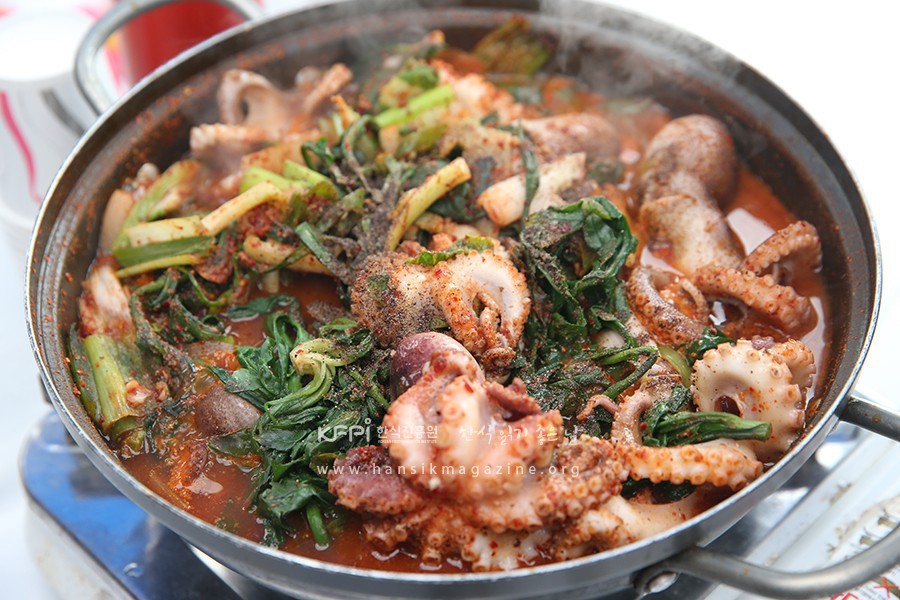
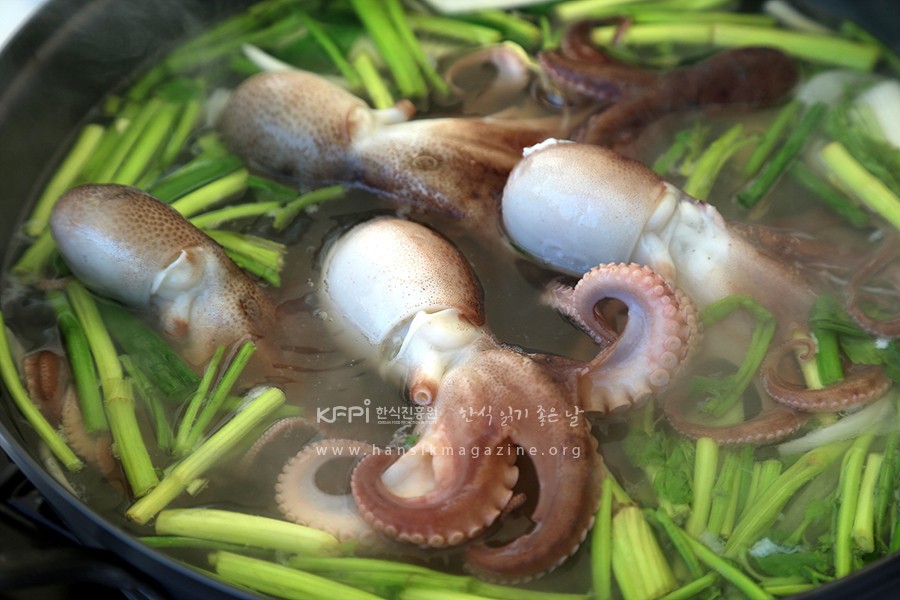
ⓒ Camellia flower and webfoot octopus festival in Seocheon
Jukkumi is Jukkumi indeed
Jukkumi belongs to Octopodidae of 8 legs together with Nakji(Octopus) and Muneo(Octopus). Albeit similar, Squid, Cuttlefish, Beka squid, etc. of 10 legs belong to oliginidae. The area in the world where jukkumi eaten is known to be Korea and Japan of East Asia and coastal countries of Mediterranean. However, there won’t be such places as Korea with diversified dishes. The same is the case with names. In English, jukkumi is called webfoot octopus in the sense of an octopus with web foot, while it is called Yiitako 飯蛸 in the sense of an octopus incubating roe in the shape of rice paste. And in the Mediterranean coastal countries and Spain, it is collectively called as Polpo. It is also used without a particular distinction from octopus as a dish ingredient. Only in Korea, jukkumi is the jukkumi rather than ‘such and such octopus’.
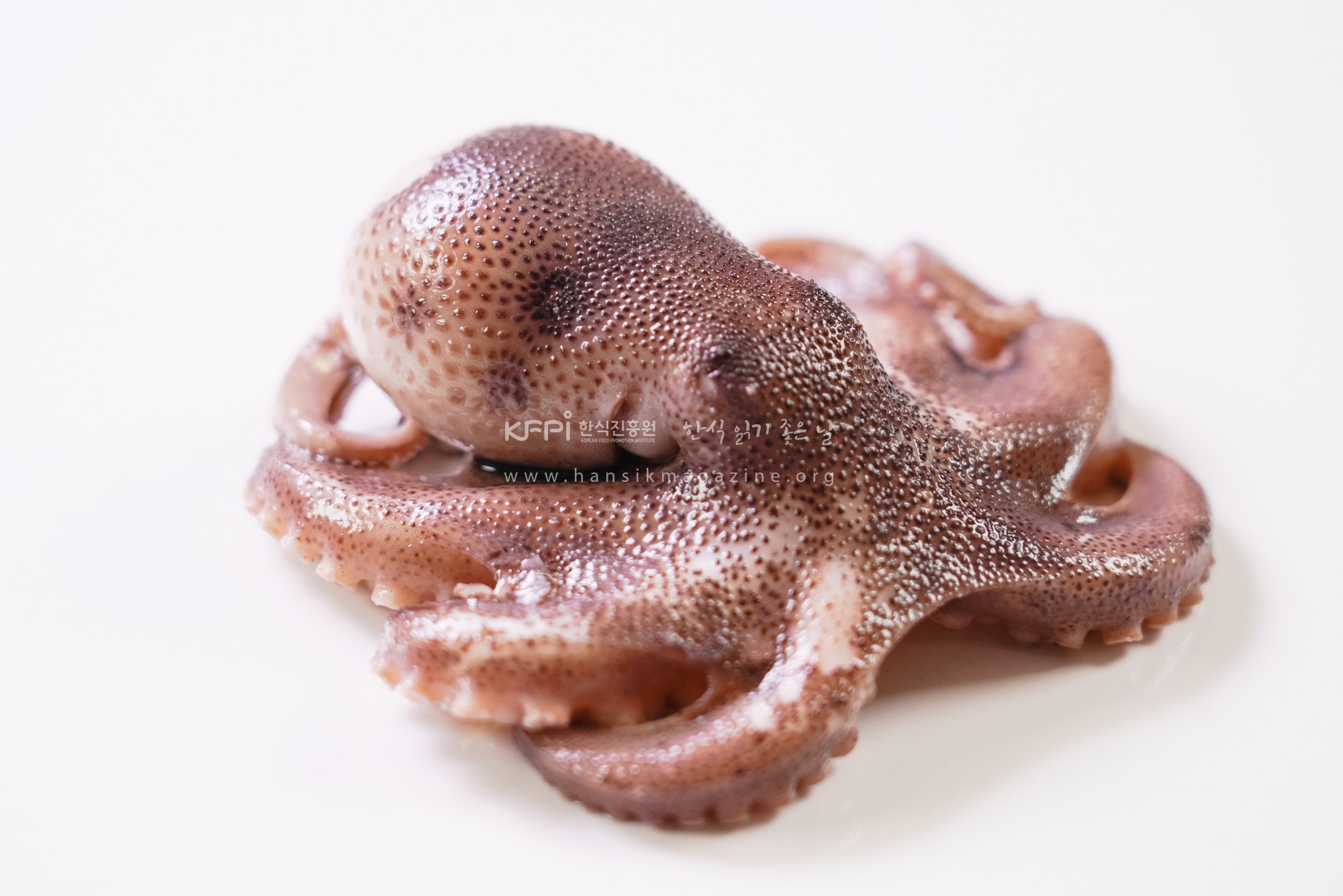
The jukkumi absolutely stands out in the nutrition as well. It contains unsaturated fatty acid and DHA know to be helpful for brain development of the children in growth period, and is rich in taurine known to be effective in recovery from fatigue and appeasing arteriosclerosis. Even the illexine composition of the jukkumi ink is considered to have anti-cancer effects. Jukkumi is the smallest among them, and yet has taurine contents as much as twice that of Nakji, 4 times of that of Muneo, 5 times of that of squid. In addition, it is said to have the effects of lowering cholesterol figures, making the nutritional value of jukkumi a ‘tower’ for prevention and cure of all diseases as they say.
When you go visit the fish market, you can see the merchants appeasing the body’s fatigue using nutrition and vigor agents such as ‘Bac*s’ while displaying fresh Nakji, Muneo, squid, Jukkumi, etc. on the display stand. As 100g of jukkumi contains as much as 1600mg of taurine, it is more than or almost equal to a bottle of ‘Bac*s’.
The appearance of drinking expensive artificial taurine in front of the natural taurine is merely an irony. While the fish store merchants must be aware of the nutritional value of jukkumi, it can be explained only by the old saying ‘Shoe merchants wear straw shoes’.
Jukkumi is not a rice thief
Tasty dishes are frequently accompanied by an analogy of 'rice thief'. The word probably means being tasty to the extent that several servings can be ingested as if the rice were stolen. Such foods are often the salty or spicy foods such as Ganjanggejang(Soy Sauce Marinated Crab), Gochujangsutbulgui(Red Chili Paste charcoal-grilled), etc. Although the rice is not certainly sought due to the spicy or salty taste, it may be considered differently that repetitive eating habits due to the excessive ingestion of carbohydrates may cause nutritional imbalance or overweight so that they are not the foods conducive to the body. In such case, ‘Too much is as bad as too little 過猶不及’ rather than ‘the more the better 多多益善’.
Jukkumi is a low-calorie food of 47kcal per 100g along with a low fat content. Since even a small piece of Yakgwa(Honey Cookie) weighing 30g produces about 150kcal, Jukkumi may be reasonably called a representative food of low calorie high protein. Even so, the jukkumi dish does not call for rice either. As long as it is not the stir-fried Jukkumi with spicy seasoning to hide the poor freshness, there is no risk of becoming a rice thief. In particular, the spring jukkumi often incubates roe called ‘jukkumi rice’ so that eating more rice is not necessarily required. therefore, jukkumi is also appropriate as a diet food with no concerns about nutritional imbalance.
The saying ‘Being on everyone’s lips’ is used to mean being frequently mentioned in people’s conversations. Namely, it refers to the high rank in portal search words. The original meaning of this saying is raw meat and grilled meat entering in people’s mouths, i.e. all foods. Thus it is used to mean being frequently mentioned. When applied to foods, wouldn’t the jukkumi fit this saying best? Possible Korean dishes ranging from hoe(sliced raw fish) to jeotgal(salted seafood) are endless. Furthermore, it is not surpassed by any food ingredients in terms of nutrition as well. it is the food ingredient with the excellent so-called cost effectiveness. That is why the jukkumi without attention being paid compared with muneo, nakji, squid that was considered only as the ordinary seashore people’s food has now become the food enjoyed most readily and as diversified dishes among the seafoods of octopodidae and loliginidae.
This year’s spring robbed by COVID-19 is not gloomy because of the jukkumi. Fragrance and taste of spring transmitted by the jukkumi resembling camellia also provide a great comfort of immunity in the season where the power of virus is so high. Although immunity is not suddenly reinforced by food alone, there will be no worries even if the life before COVID-19 is not returned to as long as you can have foods such as jukkumi with a rich nutritional value along with suitable exercise and spend pleasant times by yourself. in the social life matching the post COVID-19 era, 2020 ‘lone festival’ of jukkumi was sufficient to produce a great comfort and vitality for the body and mind. Nevertheless, the jukkumihoe(sliced raw webfoot octopus) that is difficult to taste if you are not at the production place must await the next year’s Seocheon festival of camellia flower and jukkumi. My mouth waters already. The festival has already begun inside my mouth.
Choi Kyuseung
Poet. He started his literary career with Rookie of the Year Award from <Lyric Poetry and Poetics> in 2000, and has poetical works such as <Weightless sweater(Beginning of thousand years, 2006)>, <Like like(Moonji Publishing, 2012)>, <End(Joins Prime, 2017)> and Selected handwritten poems <Time bandit(Knowledge-producing knowledge, 2013)>, etc.










